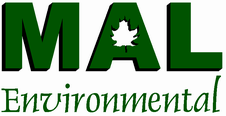 |
| |
| Asbestos |
| |
| Background |
Asbestos
is the generic name for a variety of fibrous minerals found naturally
in rock formations around the world. Because asbestos fibres are
strong, durable and non-combustible, they were widely used by industry,
mainly in construction and friction materials. Inhalation of airborne
asbestos fibres in significant quantities poses health risks and
can cause asbestosis (a scarring of the lungs which makes breathing
difficult), mesothelioma (a rare cancer of the lining of the chest
or abdominal cavity) or lung cancer.
In Ontario, a material is defined as containing asbestos if the
material has a minimum asbestos content of 0.5%. Asbestos-Containing
Materials (ACMs) can be divided into two categories: friable and
non-friable material. A friable material is a material that can
be crumbled, powdered, or pulverized by hand pressure and can readily
releases fibres when disturbed. Common application of friable asbestos
are sprayed or trowelled surfacing materials (sprayed fireproofing,
textured coatings and plaster finishes) as well as mechanical and
thermal insulations.
Non-friable materials are materials that will generally release
fibres only when cut or shaped. Common non-friable ACMs include
vinyl floor products, drywall joint compounds, asbestos textile
products and asbestos cement products (transite). Some of these
products may become friable with time or when disturbed. |
| |
| Regulatory
Requirements |
The
disturbance of asbestos-containing materials on construction projects
is controlled by the Ontario Occupational Health & Safety Act,
R.S.O. 1990, Regulation 278/05, Designated Substance – Asbestos
on Construction Projects and in Buildings and Repair Operations.
This Regulation classifies all asbestos disturbances as Minimum
(Type 1), Intermediate (Type 2), or Maximum (Type 3), each of which
has defined precautionary measures. All asbestos materials are subject
to specific handling and disposal precautions, and must be removed
before partial or full demolition. The Ministry of Labour must be
notified of any project involving removal of more than a minor amount
of friable asbestos material. All ACMs referenced in this report
were observed to be in good condition unless otherwise specified.
Disposal of asbestos waste is controlled by the Ontario Environmental
Protection Act, R.R.O., 1990, Regulation 347 as amended by O.Reg.
461/05, General – Waste Management. This regulation requires
that asbestos waste be sealed in double containers resistant to
puncture and tears, and appropriately labelled. The waste must be
disposed at a licensed waste disposal site. Proper notification
must be issued to the site representative prior to transportation
of waste. The transport of the waste to the disposal site is controlled
by the federal Transportation of Dangerous Goods Act, 1992. |
|
 |



